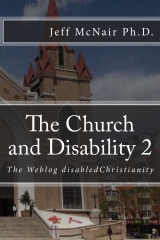To begin with, read the story of the "Good Samaritan" if you haven't ever read it before, and then continue on with this blog post. You can find it in Luke 10:30-35.
I want to think of the connections between this parable of Jesus that was provided to illustrate who a neighbor is, and how this relates to interactions with people with disabilities. Here are a few observations about what it means to be a neighbor to a person affected by disabilities.
1. Why did the man get beat up/Why does someone have a disability?
...We can ask why things happen to people but ultimately we do not know. Additionally in this story, the reason why the man was beaten is totally irrelevant: the point of the story was the response of the Samaritan who understood who his neighbor was.
2. The beaten man had everything stolen, he is in poverty with no resources of his own
...Those with disabilities may have limited or no resources of their own to assist themselves.
3. The beaten man was abused and left "half dead"/he was actually disabled temporarily or long term depending upon the severity of the beating.
...Did you ever think that the man who was beaten was actually a disabled man as a result of the beating. So, Jesus uses the example of helping a disabled man as a way of illustrating the point of being a neighbor.
4. The beaten man may have been unaware of his situation as a result of his beating, perhaps passed out (he was "half dead").
...People with disabilities (particularly intellectual disabilities) may be totally unaware of their situation and what is happening to them. It is not unlike the Leviticus 19:14 warning about cursing the deaf or putting a stumbling block in front of the blind. Although he might not recognize his situation, I do and must do what I can to help independent of what he understands.
5. Priest and Levite "saw" the man and deliberately avoided him...they saw that he was beaten (disabled) and passed by on the other side...he was not a priority for them
...I have too often been told by Christian leaders that ministry to persons with disabilities is not a priority. These leaders are exactly the same as the priest and levite who walked by on the other side. It is what I call "Know excuse"...I didn't know. Well if you didn't know, why do you have handicapped parking spaces and restrooms with the big stalls? Who do you think they are for?
6. The Samaritan, stops, takes pity on him, goes to him, and assesses his wounds to determine a course of action
...Elsewhere in this blog, I have spoken about Wolfensberger's 18 wounds. I can tell you that those wounds are a good representation of the experience of many people with disabilities. If I take the time to assess a person's situation, I can see how they are wounded and come up with some kind of solution to address the wounds. It starts by stopping, going to the person and finding out how they are wounded.
7. The Samaritan stopped to help someone that the culture clearly considered as something different from itself (Samaritan sees a Jew, non disabled sees person affected by disability)
...No doubt, Jews and Samaritans were conditioned by their cultures to see each other as different, as enemies, as other. However, the Samaritan rejects his cultural conditioning and simply acts like a neighbor to the hurting man. He sees him as a man, not a different race.
8. The Samaritan ignored the potential "danger"
...People are afraid of relationships with needy people because of the demands they might make on them. If we are to be neighbors we must ignore this "danger".
9. After assessing wounds, bandages them "pouring on oil and wine", he did what he could.
...Probably there is more that could have been done to improve the care provided, more to be learned, but he started with what he knew...then he took him to the inn to pay for further care. He did not excuse himself saying, "I don't have any training" but did what he could and then took him to people who could help him do more.
10. Ministry cost him something and the cost was ongoing to some degree but he still made the decision to get involved.
...I was once told by a pastor that ministry to people with disabilities was a "black hole for service" the implication being that I should not get involved with people who's needs will constitute and ongoing cost to me. I suspect I should just serve people who I can serve quickly and then leave alone...but is that the Christian model Jesus provides here? No the support needed was demanding and ongoing.
11. The Samaritan put him on his own donkey (gave him a ride to the place where he could be ministered to) and "took care of him" for a whole day
...The Samaritan gave him a ride to church, so to speak. When was the last time you gave someone a ride to church who was not able to get there on his own? Have you ever made two trips to church so that you could pick up others who needed to get to church?
12. Ultimately the Samaritan developed a relationship with the man via providing for his care, and looking in on him when he returned reimbursing for further expenses.
...The Samaritan didn't drop the man off at the inn and make a hasty retreat. No he took the man there, paid for what was needed and said he would come back and pay for whatever else was needed. He established a relationship with the beaten man and the caretaker of the inn in order to get the best services for the person he perceived as his neighbor.
Wednesday, April 13, 2011
Subscribe to:
Comments (Atom)










